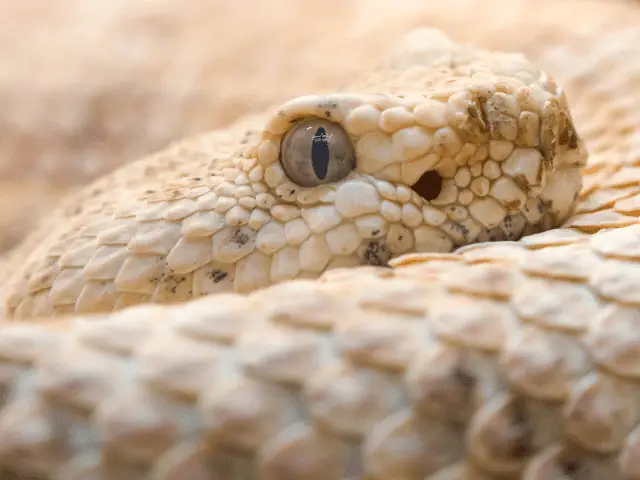Hiking with dogs can be an exciting way to enjoy the great outdoors with your canine companion, but it comes with its own unique set of safety precautions if you’re in an area with rattlesnakes!
If you don’t take the proper steps to protect yourself and your dog from rattlesnakes, you risk coming face-to-face with one of these deadly snakes when you least expect it. Here are some simple tips to help you enjoy hiking with dogs in rattlesnake country while staying safe at the same time.
This article contains affiliate links. If you purchase through one I may receive a commission.
How to Prepare for Hiking with Your Dog Near Snakes

Before you bring your dog on any hike, assess whether rattlesnakes are a possibility. If you’re hiking in rattlesnake country, you should follow these precautions:
- Wear long pants and boots
- Stay away from brushy areas
- Keep your dog on a 6-foot leash
- Watch the path ahead of your dog to make sure they don’t step on a rattlesnake
Carry a cell phone and a small first aid kit for both you and your dog . A snake bite isn’t usually fatal, but it can cause pain, swelling, muscle spasms, blood clotting, and other issues—even if it doesn’t inject poison.
. A snake bite isn’t usually fatal, but it can cause pain, swelling, muscle spasms, blood clotting, and other issues—even if it doesn’t inject poison.
Check your dog for bites after every hike to monitor their health. It’s also important to clean any wounds on your dog as soon as possible to help prevent infection.
Unfortunately, antivenom is only available at veterinary clinics and your dog may need several injections before they are fully recovered. If your dog has been bitten by a rattlesnake, call their vet immediately to get advice on how to administer treatment until the dog can be get to the vet.
If you do see a snake, never try to catch or kill it—they are protected under law—just notify wildlife management so they can collect it and find out whether there are any other snakes in that area. There are some studies suggesting that rattlesnakes are starting to rattle less or even not form a rattle because they are killed when they use their rattle tail to warn predators.
or even not form a rattle because they are killed when they use their rattle tail to warn predators.
How to Stay Safe Around Rattlesnakes
While many people are content to let rattlesnakes and other wildlife go about their business without intervention, there are still many things that you can do to make sure that your dog (and you) stay safe on your next hike.
The easiest way to avoid an encounter with a rattlesnake is to keep your eyes peeled for one. Many rattlesnakes will try to escape or hide when they hear or see you approaching—this includes young snakes and mothers who want to protect their nests. Keep an eye out for small holes, underbrush, rocks, and logs; these spots offer good cover for snakes.
Check your shoes before putting them on if you take them off during the hike. A snake could be resting inside or under them—not something you want to learn only after stepping into a potentially dangerous situation!
If you do happen to spot a rattlesnake, do not approach it. Snakes will generally try to slither away if they feel threatened. However, when startled or provoked—such as by a dog who starts chasing them—rattlesnakes are more likely to strike first.
When hiking with dogs, it’s also important to keep your dog leashed and under control at all times. If your dog is chasing or harassing a snake, use your leash and body weight to keep it at bay.
Finally, if you have a bite victim on your hands—yourself or one of your dogs—immediately seek medical help. Remain calm and remove yourself and your dog from the snake’s strike range.
You may also want to read up on snake bite first aid before you go hiking so that you are prepared in the event that a bite does occur.
before you go hiking so that you are prepared in the event that a bite does occur.
With these precautions in mind, you should have no trouble enjoying your next hike. Just remember to keep a lookout for rattlesnakes and other wildlife while keeping a close eye on your four-legged hiking companions!
Remember to bring enough water for yourself and your dog, including an emergency bottle to clean wounds. You may also want to carry alcohol sawbs in your first aid kit.
How to Identify Dangerous Snakes

There are more than 10,000 species of snakes on Earth, and most are harmless. However, there are several types of venomous snakes you should know how to identify.
You can use online resources to find out which venomous snakes are in the state that you are planning your hike . Learn how to identify each type of snake so that if there is an incident where you or your dog are bitten, you can get the appropriate anti-venom from your vet or doctor.
. Learn how to identify each type of snake so that if there is an incident where you or your dog are bitten, you can get the appropriate anti-venom from your vet or doctor.
Most snakes are not aggressive toward humans and will only attack if they feel threatened. If you come across a snake while hiking, give it plenty of space. Watch out for warning signs of danger from snakes, including hissing or rattling noises, and remain as still as possible.
Snakes can be hard to identify, but there are a few key features you should look for to determine if it might be venomous:
- Flat, arrow shaped head
- Elliptical, cat shaped eyes
- Sensory pits near their nostrils
If you are unsure if the snake on your trail is venomous or not, always assume that it is and keep your distance! Even a non-venomous snake bite can cause damage if you or your dog is bitten.
What to do if Your Dog is Bitten by a Rattle Snake
If you are hiking or camping in rattlesnake country, the best think to do is to take steps to prevent your dog from getting bitten. However, if your dog is bitten by a rattlesnake, get it to a veterinarian immediately.
All dogs need to be treated by a vet if they are bitten by a rattlesnake. Small dogs (for example, Yorkies or Chihuahuas) will succumb to the effects sooner than large dogs, but large dogs will suffer excruciating pain until they can get treatment.
The sooner you seek treatment for your dog after it has been bitten, the better its chances of survival will be.
If your dog is bitten by a rattlesnake, and you know where it happened there are some first aid steps you can take until you can get your dog to a vet:
- Rinse the wound with water to try to remove some of the venom
- Keep the wound below the dog’s heart
- Try to keep your dog calm and prevent them from licking the area
Getting your dog to the vet as quickly as possible is a top priority if your dog is bitten. The best course of action is prevention though!
Follow the above tips to help avoid an encounter.
